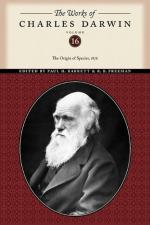certain whole groups of animals, as with cuttle-fish
and spiders, and with a few members of the great class
of insects, as with Aphis. With respect to the
final cause of the young in these cases not undergoing
any metamorphosis, or closely resembling their parents
from their earliest age, we can see that this would
result from the two following contingencies; firstly,
from the young, during a course of modification carried
on for many generations, having to provide for their
own wants at a very early stage of development, and
secondly, from their following exactly the same habits
of life with their parents; for in this case, it would
be indispensable for the existence of the species,
that the child should be modified at a very early age
in the same manner with its parents, in accordance
with their similar habits. Some further explanation,
however, of the embryo not undergoing any metamorphosis
is perhaps requisite. If, on the other hand,
it profited the young to follow habits of life in any
degree different from those of their parent, and consequently
to be constructed in a slightly different manner,
then, on the principle of inheritance at corresponding
ages, the active young or larvae might easily be rendered
by natural selection different to any conceivable
extent from their parents. Such differences might,
also, become correlated with successive stages of
development; so that the larvae, in the first stage,
might differ greatly from the larvae in the second
stage, as we have seen to be the case with cirripedes.
The adult might become fitted for sites or habits,
in which organs of locomotion or of the senses,
etc.,
would be useless; and in this case the final metamorphosis
would be said to be retrograde.
As all the organic beings, extinct and recent, which
have ever lived on this earth have to be classed together,
and as all have been connected by the finest gradations,
the best, or indeed, if our collections were nearly
perfect, the only possible arrangement, would be genealogical.
Descent being on my view the hidden bond of connexion
which naturalists have been seeking under the term
of the natural system. On this view we can understand
how it is that, in the eyes of most naturalists, the
structure of the embryo is even more important for
classification than that of the adult. For the
embryo is the animal in its less modified state; and
in so far it reveals the structure of its progenitor.
In two groups of animal, however much they may at
present differ from each other in structure and habits,
if they pass through the same or similar embryonic
stages, we may feel assured that they have both descended
from the same or nearly similar parents, and are therefore
in that degree closely related. Thus, community
in embryonic structure reveals community of descent.
It will reveal this community of descent, however
much the structure of the adult may have been modified
and obscured; we have seen, for instance, that cirripedes




